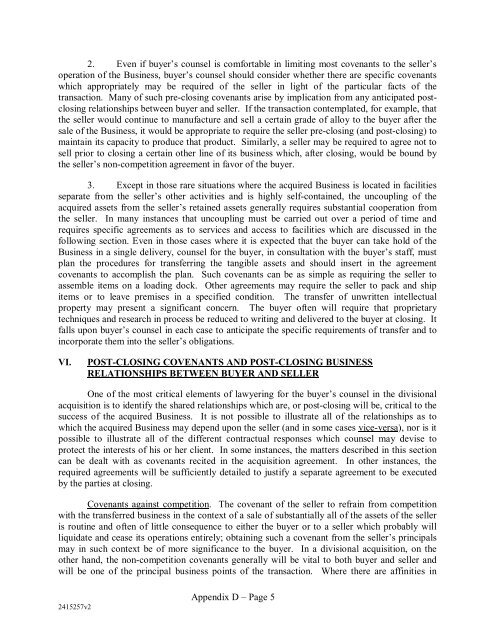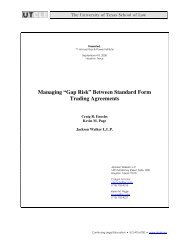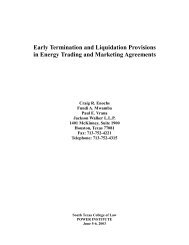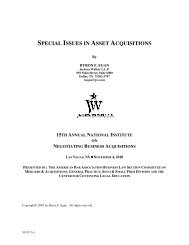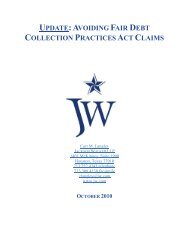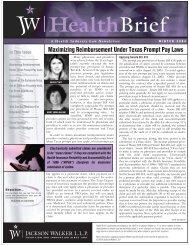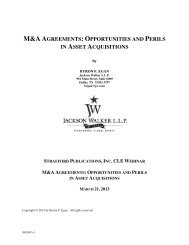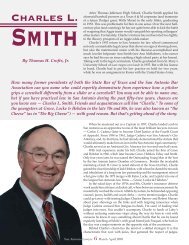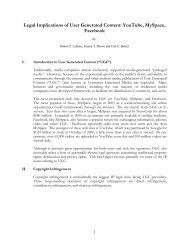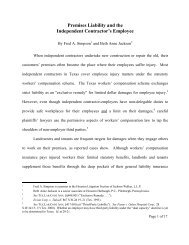asset acquisitions - Jackson Walker LLP
asset acquisitions - Jackson Walker LLP
asset acquisitions - Jackson Walker LLP
Create successful ePaper yourself
Turn your PDF publications into a flip-book with our unique Google optimized e-Paper software.
2. Even if buyer’s counsel is comfortable in limiting most covenants to the seller’soperation of the Business, buyer’s counsel should consider whether there are specific covenantswhich appropriately may be required of the seller in light of the particular facts of thetransaction. Many of such pre-closing covenants arise by implication from any anticipated postclosingrelationships between buyer and seller. If the transaction contemplated, for example, thatthe seller would continue to manufacture and sell a certain grade of alloy to the buyer after thesale of the Business, it would be appropriate to require the seller pre-closing (and post-closing) tomaintain its capacity to produce that product. Similarly, a seller may be required to agree not tosell prior to closing a certain other line of its business which, after closing, would be bound bythe seller’s non-competition agreement in favor of the buyer.3. Except in those rare situations where the acquired Business is located in facilitiesseparate from the seller’s other activities and is highly self-contained, the uncoupling of theacquired <strong>asset</strong>s from the seller’s retained <strong>asset</strong>s generally requires substantial cooperation fromthe seller. In many instances that uncoupling must be carried out over a period of time andrequires specific agreements as to services and access to facilities which are discussed in thefollowing section. Even in those cases where it is expected that the buyer can take hold of theBusiness in a single delivery, counsel for the buyer, in consultation with the buyer’s staff, mustplan the procedures for transferring the tangible <strong>asset</strong>s and should insert in the agreementcovenants to accomplish the plan. Such covenants can be as simple as requiring the seller toassemble items on a loading dock. Other agreements may require the seller to pack and shipitems or to leave premises in a specified condition. The transfer of unwritten intellectualproperty may present a significant concern. The buyer often will require that proprietarytechniques and research in process be reduced to writing and delivered to the buyer at closing. Itfalls upon buyer’s counsel in each case to anticipate the specific requirements of transfer and toincorporate them into the seller’s obligations.VI.POST-CLOSING COVENANTS AND POST-CLOSING BUSINESSRELATIONSHIPS BETWEEN BUYER AND SELLEROne of the most critical elements of lawyering for the buyer’s counsel in the divisionalacquisition is to identify the shared relationships which are, or post-closing will be, critical to thesuccess of the acquired Business. It is not possible to illustrate all of the relationships as towhich the acquired Business may depend upon the seller (and in some cases vice-versa), nor is itpossible to illustrate all of the different contractual responses which counsel may devise toprotect the interests of his or her client. In some instances, the matters described in this sectioncan be dealt with as covenants recited in the acquisition agreement. In other instances, therequired agreements will be sufficiently detailed to justify a separate agreement to be executedby the parties at closing.Covenants against competition. The covenant of the seller to refrain from competitionwith the transferred business in the context of a sale of substantially all of the <strong>asset</strong>s of the selleris routine and often of little consequence to either the buyer or to a seller which probably willliquidate and cease its operations entirely; obtaining such a covenant from the seller’s principalsmay in such context be of more significance to the buyer. In a divisional acquisition, on theother hand, the non-competition covenants generally will be vital to both buyer and seller andwill be one of the principal business points of the transaction. Where there are affinities in2415257v2Appendix D – Page 5


